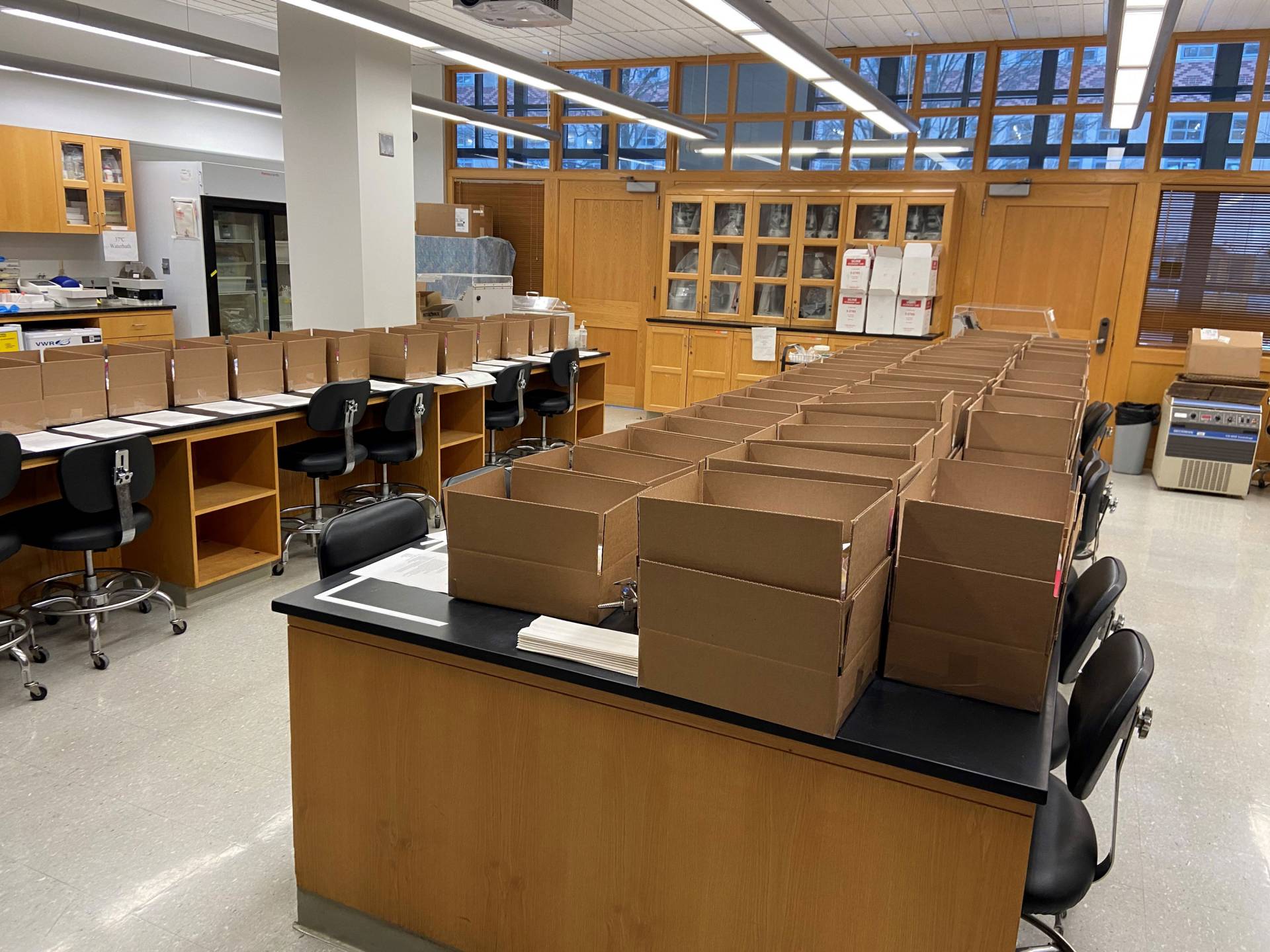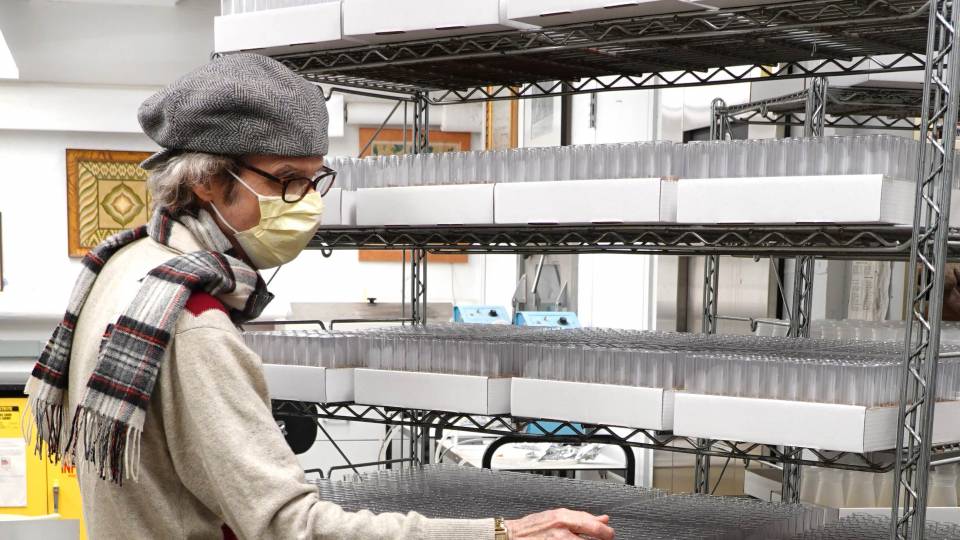Princeton faculty have found a number of innovative ways to teach remotely, from mailing archival materials to virtually choreographing dances. But how can you teach science when the labs themselves are shuttered?
Professors in engineering and the natural sciences have found a multitude of creative solutions, from setting up remotely controllable lab equipment to shipping kits of supplies to students’ homes to restructuring lab assignments to be done one at a time in the few still-operating lab spaces.
“The faculty have been extraordinary, rising to meet every challenge,” said Katherine Stanton, an associate dean and the director of the McGraw Center for Teaching and Learning. Since the advent of online instruction a year ago, the McGraw Center team has devised a wealth of resources for faculty and instructors, remotely teaching the teachers about what resources are available and helping them adapt their curricula and labs to online learning.
“Faculty have gotten quite creative to teach labs,” said Stanton.
Programmers at home control robotic mechanisms in the lab
The instructors of “Automatic Control Systems” arranged to have teams of students remotely control robotic mechanisms located in one of the engineering labs.
“Mike Littmann created this incredibly cool setup,” said Stanton. “Students conduct the experiment remotely, with the teaching assistants serving as their hands in the laboratory.” Littman, a professor of mechanical and aerospace engineering, created the course and many of its labs 20 years ago.
For one of these experiments, seen in the video above, students had about two hours in which to make a rotatable robotic platform balance a swinging rod — a very modern take on the old game of balancing a broom upright on your palm. The students programmed the lab computer attached to the platform from their remote locations. They watched the results with the help of pan-tilt-zoom cameras at each workstation that let them view the laboratory setup and the real-time action of the equipment.
“There were many problems that we had to solve to adapt the labs for remote operation,” said Littman, who worked with the current professor, Clarence Rowley, and Jon Prevost, senior technical support staff, to find ways to keep teaching through the pandemic.
“Some parts had to be scrapped — we couldn’t have the students weigh components on a scale and measure them with calipers, so instead we just told them the weights and dimensions — but the real challenge was having a group of students share the control of a laboratory workstation,” Littman said. “With Jon’s help, we figured out how to use Zoom’s remote features in the breakout rooms. We had each workstation share its screen with the breakout room and let the students in the breakout room take control of that computer.”
The students, working in teams of three, were so self-sufficient that six teams could work simultaneously without overwhelming the two teaching assistants in the lab or the professor. “I consider this a success,” Littman said. “We are using similar approaches to carry out some laboratory experiments this semester in several other courses.”
Boxes full of petri dishes sent around the world
Other classes brought the science physically to their students. The instructors for Introduction to Cellular and Molecular Biology, taught this year to 80 students in the fall and 175 in the spring, packaged and shipped lab kits to students around the world. (On-campus students picked up their boxes at Frist Campus Center.)

Every student enrolled this year in “Introduction to Cellular and Molecular Biology” received a package filled with the equipment they needed to perform their labs. The kits were boxed up in Schultz 105, the course’s teaching lab. “I’m very much looking forward to having the lab filled with students instead of boxes in the fall!” said Heather Thieringer, who has taught the course for 15 years.
The faculty also re-thought the goals of some labs, leading to changes that will likely stay in place long after the return of fully in-person instruction.
“There are skills beyond just what you do physically,” said Heather Thieringer, a senior lecturer in molecular biology who has taught this course for 15 years. “How do you analyze data? How do you present the data in a figure? We shifted focus to the kind of skills that have to do with scientific thinking: how to think about a hypothesis, how to design a controlled experiment.”
For example, every year until this one, students have cloned DNA early in the semester, she said. “We’d hand them test tubes and say, ‘This is your plasmid, this is your vector, this is the buffer. Pipette them all together and — oh, look, you cloned something!’’’
With that no longer possible, they turned the lab inside out, inviting the students to design the lab instead of executing it, using a program that Princeton faculty use in their own research labs. “We said, ‘This is the gene you want to clone, so you’re going to have to figure out how to do this: What enzymes should you use? How can you piece this together?’” Thieringer said.
It’s like teaching chefs not by handing them a recipe but asking them to write their own.
“I think it’s actually better for them to think about the thought process that happens before you get your hands on the equipment,” said Laurel Lorenz, a lecturer in molecular biology who also teaches the course.

Each kit contained the equipment for a semester’s worth of biology labs, including safety glasses, gloves, a micropipette, pipette tips, petri dishes, microfuge tubes, a P51 blue LED light viewer box and much more.
While half of the class’s labs became fully virtual, designing experiments or analyzing existing data, the other half remained hands-on labs — which meant the instructional team had to get creative.
For one lab, students added yogurt, which is available in most countries around the world, to the petri dishes and agar shipped by the University.
“That way they could culture bacteria, but nothing that they were growing was dangerous,” Thieringer said. “They were just growing the beneficial, probiotic bacteria that are in yogurt.”
That lab worked well in the fall, but had to be adapted for the spring, because with the dorm kitchens closed, many on-campus students no longer had access to cooktops or microwaves, or even refrigeration.
“I have to give a shout-out to the lab staff themselves,” Thieringer said. “They normally prepare all of the materials needed for getting 180 students into the lab for the week, and they have now pivoted and become experts at packing and shipping. Once, I came into the lab and saw them putting packaged test tubes on a shake table to make sure they would survive days of jostling in transit! We’ve gotten a kit, both semesters, to every single student, no matter where they are in the world.”
Hands-on physics for socially distanced physicists
A few classes, including “Experimental Physics,” were given permission to use campus lab facilities, if they followed strict social distancing precautions established by the Office of the Dean for Research. The instructors prepared 12 labs and the students chose five that they can do in any order, typically with a different lab partner every time.
Each assignment requires multiple visits to the lab to gather data. That is a boon this year, since it means each student has a chance to physically use the equipment without having to spend hours in a small room with a lab partner.
“One will go into the lab and the other will participate via Zoom, and then they will alternate sessions,” explained Norman Jarosik, a lecturer and senior research physicist who won the 2018 Breakthrough Prize in physics.
“The most important thing about these experiments is getting experience with the equipment,” Jarosik said. “We want students to actually touch it.”
Some experiments start with a few-minute introduction to the equipment from a masked professor or instructor standing several feet away, but after that, the students are on their own, working with their Zoom-based partner. “If they have any trouble, they’ll email me, we’ll hop on Zoom, and usually we can straighten up whatever the problem is,” Jarosik said. “We don’t want them to get stuck or frustrated.”

Princeton students in “Experimental Physics” remotely direct this InfoAge Space Exploration Center radio telescope to gather data from pulsars — dying stars that give off regular bursts of radio waves as they rotate.
One of the most popular labs is “naturally” remote, said Jarosik, since it requires controlling a radio telescope 40 miles away. While the department has taken occasional field trips out to visit the 60-foot-high telescope, it can be controlled from anywhere. For the lab, students use their laptops to listen for pulsars — small, rapidly spinning stars.
This spring, two students in the course are not on campus; for their labs, their partners have done all the hands-on work, and they share the data analysis. For the final lab of this semester, Jarosik will pair them up for what he’s calling a “flipped lab,” where he will be in the lab himself while both of them Zoom in, and they will direct each step he takes from their homes in Zimbabwe and China.
Despite the logistical hurdles, Jarosik says that the semester has been successful. “The students are doing very well — I don’t notice any difference in the quality of lab reports from normal years to right now,” he said. “And I think the students are very happy to be able to get out of their dorms and be hands-on.”
Building digital community: Bite-sized lectures and small-group interaction
Even science courses that did not have a lab component still had to get innovative. “Half of my lectures are chalkboard lectures,” said Corina Tarnita, an associate professor of ecology and evolutionary biology who teaches “Mathematical Modeling in Biology and Medicine.” “How do you keep anyone engaged in thinking about equations through a computer?”
She read everything she could find on virtual instruction, especially the materials organized by the McGraw Center and the Office of the Dean of the College.
“This year I relied on the McGraw Center more than ever,” Tarnita said. “And so have my two fantastic teaching assistants, Mari Kawakatsu and Merlijn Staps.” She praised several specific suggestions, such as pre-recording lecture videos as 20-minute segments to give students “natural stopping points” to pause and reflect on the material and getting creative with the live meetings, which she structured as a mix of teaching, problem solving-sessions and journal club-style presentations.

Corina Tarnita (top right) teaches a small-group lecture for “Mathematical Modeling in Biology and Medicine.” To keep students engaged despite social distancing, Tarnita broke up her usual three-hour lectures into a series of 20-minute video modules to cover the first two hours of material, then taught the third hour several times each week to small groups.
In a typical year, Tarnita would give 30 students three hours of lecture per week, usually while filling chalkboards with equations. For virtual instruction, she pre-recorded the first two hours of each lecture (as a series of 20-minute modules), and then she taught the final hour three times to groups of 10 students, “so that I could have small-group interactions with my students.”
She also used Slack, Google surveys, and other tools and techniques to help the class build community and to get real-time feedback from the students.
“There were many, many simple things, but they added up to so much,” Tarnita said.
Her students agreed, according to the anonymous raves they posted on the registrar’s review site. In one, a student wrote, “Please take this class! … I kind of hope that by the time this class runs again, courses will be in-person, but in the event they’re not — it’s also a really good online class!”
“That was wonderful to hear,” Tarnita said, “since this was not a trivial change. It was a rethinking of the whole package. But the students were game to try out different things and more eager than ever to be present and engaged, which made it a really fun and educational teaching experience for the three of us. There are quite a few ideas that I will keep even when we move to in-person instruction.”






